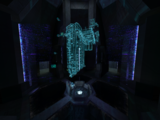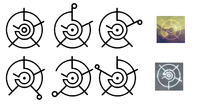Forerunner
From Halopedia, the Halo wiki
- "We are Forerunners, guardians of all that exists. The roots of the galaxy have grown deep under our careful tending. Where there is life, the wisdom of our countless generations has saturated the soil. Our strength is a luminous sun towards which all intelligence blossoms. And the impervious shelter beneath which it has prospered."
- — The Ur-Didact, giving a speech on the purpose of the Mantle.
The Forerunners were an ancient species of Tier 1 beings whose empire -- known as the ecumene -- encompassed three million fertile worlds in the Milky Way Galaxy approximately 100,000 years ago.[1] The Forerunners were the creators and builders of many significant installations, including the Halo Array, the Ark, and the shield worlds, as well as numerous lesser artifacts later found on many worlds.
The Forerunners had taken up a role as custodians of the galaxy, and believed that this "Mantle" had been passed down to them by the Precursors, an even more powerful race that preceded the Forerunner civilization.[2] "Forerunner" is a literal translation of the species' name for themselves; they identified themselves as such because they believed that they held an impermanent place in the universe's Living Time and that they would be succeeded by other, better races.[3] Before their disappearance from the galaxy, the Forerunners would name humanity their successors, identifying them with the title "Reclaimer".
The alien faction known as the Covenant worshiped the Forerunners as gods, deriving much of their technology from Forerunner artifacts found throughout the galaxy, and believing any who defaced these relics to be heretics.
Known history
Origins
The Forerunners were created by the Precursors, a powerful race responsible for seeding the Milky Way Galaxy with life and creating many other species, including humans. Over ten million years ago, the Precursors chose humanity to inherit the Mantle, the guardianship of all life in the galaxy. Provoked either by this revelation alone or, possibly, the Precursors' alleged decision to eradicate the Forerunners as a "problematic" species,[4][5] the Forerunners responded by overthrowing their creators, exterminating most of them in retaliation. The Forerunners, led by the then-dominant rate of Warriors, began their thorough campaign of extermination in the Milky Way galaxy and later chased the last Precursors down to the satellite galaxy of Path Kethona. There, they would finish their work, eradicating all but a few Precursors who managed to elude the Forerunners. However, some Forerunners began to question the ethics of the genocide and refused to take part; many were summarily executed, while others were exiled on a barren planet in Path Kethona without any advanced technology. This population would survive for millions of years, carrying the memories of the past in their unique genetic memories. However, they would remain as the last survivors of the fleet that traveled to Path Kethona, as those who had carried out the genocide until the end never returned to the Milky Way.[6] Records of this war were gradually lost to time over millions of years, and Forerunner civilization as of 100,000 BCE believed that the Precursors had simply disappeared and left the Mantle over to the Forerunners.
The Forerunners originated on the planet Ghibalb in the Orion complex. The world served as the hub of the Forerunners' fledgling interstellar civilization, comprised of twelve systems within the nebular complex, until it was rendered uninhabitable by an astroengineering disaster. The Forerunners had attempted to manipulate several stars in their region of space, but accidentally caused a series of supernovae that resulted in their planet being burned to a cinder by radiation. This event nearly caused the Forerunners' extinction.[7]
The Forerunner civilization rose to preeminence in the galaxy in roughly 150,000 BCE,[8] around the same time humanity first began moving its first interstellar civilization away from their homeworld, supposedly to escape early Forerunner control.[9] The capital, the center of the Forerunner ecumene and the seat of the Ecumene Council, was constructed around 125,000 BCE.[10] The Forerunners reached their peak before activating the Halo Array around 100,000 BCE, in the closing days of their war with the Flood.[11][12]
Human-Forerunner war
- Main article: Human-Forerunner war
Around 110,000 BCE, the Forerunners went to war with humanity's interstellar empire, in response to a perceived invasion of worlds where the Forerunners had relocated other species.[13] This invasion was thought to be caused by both human resentment at Forerunner expansionism during the previous fifty years and by the rapid growth of human populations.[14] After the war, a small number of Forerunners discovered the true cause of the invasion: a desperate human migration away from an extragalactic parasite known as the Flood. Desperate for new, uninfected worlds to replace the ones lost to the Flood, humanity invaded the worlds of other civilizations, bringing them into direct conflict with the Forerunners, who saw themselves as protectors of the Mantle.[15]
The Forerunners perceived humanity's actions to be a threat to the principles of the Mantle, and therefore waged a decisive war against humans, subjugating every human-controlled world and wiping them clean of all traces of human civilization. As punishment, humanity was stripped of its empire and technology and was exiled to its homeworld, Erde-Tyrene. There, humanity was devolved, splintered among its collective species and forced to begin anew.[13][16] The Flood, meanwhile, had been pushed beyond the edge of the galaxy by humanity's military efforts, and all traces of its existence vanished.[15]
Following the events of the war with humanity, a select group of Councilors and other elite Forerunners turned their attention to the possibility that the Flood would return. The Didact advocated a policy of watchfulness and military readiness, and proposed the construction of a series of Shield Worlds to provide quick military support should the Flood reappear. However, this plan was overruled by the council in favor of one put forward by a faction of Forerunner Builders, who proposed the construction of an array of galaxy-sterilizing super weapons as the ultimate defense against such a threat. These proposed weapons would be designed to starve the Flood to death by killing all sentient life in the galaxy with enough biomass to sustain them.[17]
The Council's acceptance of this plan caused the Librarian, a prominent Forerunner Lifeworker and the wife of the Didact, to speak out in condemnation of the Builders' proposal of mass genocide, and as a result she and other Lifeworkers were permitted to work on the project as well, integrating their own measures for preserving the galaxy's life into the plan. The plan, the Conservation Measure, resulted in the Lifeworkers gaining biological preserves on the Builders' installations, including two Arks and a network of massive ring-shaped superweapons known collectively as the Halo Array. Meanwhile, the Didact and the other Prometheans who had supported his cause were removed from the council and executed or exiled. The entire Warrior-Servant rate would be marginalized over the next thousand years, with their fleets and armies disbanded, leaving the Forerunners ill-prepared when the Flood would re-emerge.[18]
Forerunner-Flood war
- Main article: Forerunner-Flood war
Roughly nine thousand years after their war with the humans, a Forerunner survey team on the planet Seaward came into contact with the Flood. After this first contact, the Forerunners immediately recognized the great danger that the Flood posed to the entire galaxy and attempted to contain them. Even though they knew the power of the Flood, the principles of the Mantle forbade them from destroying it. As such, the attempt to contain the Flood was a failure, as they tried methods more suited to disease control instead of all-out warfare, trying to contain and quarantine the Flood rather than attack and destroy it outright. They did not start war until it was far too late.[19]
When the Forerunners were unable to contain the Flood outbreak, the galaxy entered a state of war. During the 300 years of the conflict, the Forerunner studied the Flood in labs such as the gas mine located in the atmosphere of Threshold, looking for any exploitable weakness. As the Forerunners soon realized that conventional naval tactics were ineffective against the parasite's onslaught, they developed new weapons and tactics to combat the Flood. The Sentinels were deployed as a means of maintaining the Flood through surgical, localized tactics. The Forerunner fleet command even contemplated using naval battle groups to enact premature stellar collapse within compromised planetary systems, causing supernovae to engulf entire worlds.[20] However, as these tactics proved only to slow, but never stop the expansion of the Flood, the Forerunner leadership realized that the only way to stop the Flood was to deprive it of any and all hosts, thus eliminating its potential to grow.[17]
Firing of the Halo Array
- "After exhausting every other strategic option, my creators activated the rings. They and all additional sentient life within three radii of the galactic center, died, as planned."
- — 343 Guilty Spark on the fate of the Forerunners.
Even at this late hour, the Forerunners were reluctant to use the Array, believing that they should continue to embrace the Mantle and to protect life rather than to destroy it. This led to great stretches of anguished debate and even civil war, but eventually it was decided that the Array was the only means of successfully stopping the Flood threat.[21] The Gravemind managed to convince a Contender-class AI, 032 Mendicant Bias, to unite with the Flood. Mendicant Bias soon led his massive fleet in an attack on the "Maginot Line", the final barrier between what the Forerunners could protect and what they were forced to abandon to the Flood. At last, the Forerunners exhausted every alternative and activated the Halo Array, killing themselves and all sentient life of sufficient biomass in the Milky Way,[22] with the exception of those species safely placed on the Ark.[19][23]
After the Array was fired and the Flood had been eliminated, the species the Forerunners had placed on Installation 00 were returned to their home planets. This was done by the remaining Forerunners under the command of the IsoDidact and new Lifeshaper Chant-to-Green. After the reseeding of the Galaxy was complete the remaining Forerunners left to an unknown location, as according to the IsoDidact, they were done meddling.[24]
Legacy
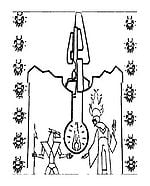
After their disappearance, the Forerunners left behind a great deal of artifacts, many of the more significant ones overseen by their dedicated monitors which would react to outside visitors in accordance with their programmed instructions. The mystery surrounding the Forerunners and their technology would later become a source of worship, legend, advanced technology, or combination thereof for the various future civilizations which eventually stumbled upon some of the many Forerunner artifacts across the galaxy.[25]
The first known species to make use of reverse-engineered Forerunner technology were the Sangheili and San 'Shyuum, having evolved on worlds rich in Forerunner artifacts. Regarding these artifacts and their creators with religious reverence, many wars broke out over whether the relics should be left in peace or used to advance their own technology.[26] Those who believed the latter came together to form the hegemony known as the Covenant, who together created a complex religion based around venerating the Forerunners as gods. Due to misinterpreting the ancients' records, the Covenant believed that the Forerunners disappeared from the galaxy after the Halo Array elevated their species to a state of trans-sentient godhood. As such, they appropriated many Forerunner technologies and artifacts, such Luminaries that let them track Forerunner-made objects all across the galaxy. The most holy of these artifacts, the "Sacred Rings" or Halo installations, were constantly searched for 1700 years, since the Covenant believed themselves to be the chosen inheritors of the Forerunners' legacy,[27] and by locating and activating the Halo Array, they believed that they too could follow the Forerunners into godhood.[28] This was referred to as the "Great Journey" by the Covenant races.[29][25] This mimicry of the Forerunners' remnants caused the Covenant to rise to a high technological tier very quickly, but additionally stunted their innovation of said technology and kept them from uncovering its true potentials.[30][31]
As for humanity, they had been chosen by the Forerunners to carry the title of "Reclaimer" and eventually take over the Mantle. The Librarian had imparted humanity with a species-wide geas;[32] these genetic instructions include an innate familiarity with Forerunner technology.[33][34] However, humans themselves were unaware of this and came into contact with Forerunner artifacts relatively late in their history, after they had colonized many planets. In 2491, a collective of human artificial intelligences uncovered the presence of Forerunner relics on Onyx and kept them hidden in the meantime for fear that humanity was not yet ready to use such advanced technology. As such, archaeological excavations did not uncover them until 2511, and the UNSC's Office of Naval Intelligence responded by hiding the planet's location and securing the area. However, little progress was made in translating any of the relics.[35] Other relics were discovered on Reach, Earth, and many other colonies. A Reach titanium mine had been shut down when they breached a Forerunner complex, and SWORD and CASTLE Base were built to guard relics' locations.[36] The Portal at Voi was buried under New Mombasa and undiscovered until much later, prompting ONI to construct a major facility to study and cover up the structure from the general population.[37] Mixed reactions came from scientists who studied the artifacts, some fascinated by their potential, others fearful for the possibility of a two-front war.[38]
Artifact involvement
- "Mankind is outmatched. When Reach falls - and it will fall - our annihilation is all but certain. Unless...we can glean from this artifact a defense against the Covenant. A game-changer. On the level of the conical bullet in the nineteenth century, or faster-than-light travel in the twenty-third."
- — Dr. Catherine Halsey, after decrypting the Forerunner artifact under SWORD Base.
Forerunner artifacts became instrumental to beginning and ending the Human-Covenant War. First contact was made when humanity's Reclaimer status was discovered by the Covenant, who did not understand that they were being labeled as Forerunner objects. The Hierarchs of the Covenant soon learned humanity's status as apparently living descendants of their supposed gods, and found it potentially destructive to their religion. Thus they decided to hide this information from the general population and ordered that humanity be eradicated, a goal in which they nearly succeeded.[39] Battles were fought often with relics at the center of the conflict, sometimes risking giving the Covenant victory early, other times hindering them and turning in favor of humans due to the Covenant's reluctance to damage Forerunner treasures. Many relics were destroyed by humans often as traps for Covenant or to keep them from falling into enemy hands.[40][41]
The most important of Forerunner artifacts to be involved was the Halo Array, the first ring of which was discovered on the heels of the destructive Fall of Reach.[42] The resulting Battle of Installation 04 revealed to humanity the existence of the Forerunners and their sacred place in the Covenant's religion, as well as the rings' true purpose as weapons of mass destruction. The activation of the Halos led to the awakening of other Forerunner relics, such as the Sentinels of Onyx, or the Ark that controlled the Halo Array. Humanity's utilization of Forerunner tech was thus regarded as a "game-changer" to turn battles into their favor[43] and also changed the goal of the war, now to keep the Covenant from reactivating the Array in their misguided pursuit of apotheosis. As the conflict drew to a close, the Covenant had been plunged into disarray as some discovered the Great Journey was false and thus seceded to ally with humanity.[44] The final battle of the war was fought aboard the Forerunners' Ark, and the UNSC and Covenant separatist forces together secured the Halo Array, destroying the Ark shortly afterward. In the post-war years humanity was beginning to reclaim its appointed place, gaining many technological leaps as a result of acquiring and reverse-engineering Forerunner technology with the assistance of a number of Huragok they had managed to procure.[45]
Return
- "Time was your ally, human, but now it has abandoned you. The Forerunners... have returned."
- — The Ur-Didact to John-117, after being awakened in the interior of Requiem.
An unknown number of Forerunners may have survived through to modern times,[46] although only one, the Ur-Didact, is known to have survived with definite certainty, imprisoned in a Cryptum in the shield world Requiem. Some information suggests that the Librarian may also have survived in some form.[47]
In July 2557, the Ur-Didact and his mechanized Promethean forces were accidentally awakened by Spartan John-117 who had stumbled upon Requiem. The Didact disregarded humanity's Reclaimer status and maintained his belief that only the Forerunners were worthy of the Mantle. The Didact and his Prometheans, allied with the Covenant remnant, went to war against humanity, aiming to prevent them from claiming the Mantle to themselves. Attempting to use the Composer to neutralize humanity by converting them into digital form, the Didact attacked Earth. However, the Master Chief and his AI Cortana stopped and defeated him, destroying the Composer and the Didact's ship. They were aided in this by the Librarian who had left an imprint of her memories behind on Requiem. The Librarian's memories augmented the Master Chief's genetic code in order to allow him to face the Didact, giving him, along with other things, an immunity to the Composer that saved his life. However, the Promethean-Covenant alliance was not defeated by this setback and the conflict was still in progress in early 2558 when the UNSC Infinity returned to Requiem.[48]
Physiology
The Forerunners were a bipedal species resembling humans in overall shape, though they were larger in stature. Before their first mutation, they were tall and slender, and possessed patches of fine, purple-pink or white fur on the top of their heads, along their nape and shoulder area, as well as the backs of their hands.[49] Their facial features were similar to those of humanity, and they were capable of making analogous expressions, but this changed as they mutated to their higher forms, which characteristically had stiffer facial muscles and a more limited ability to convey emotions.[50] Unlike humans, Forerunners lacked pronounced noses, having two slitted nostrils instead.[48] Their skulls otherwise bore a very strong resemblance to those of humans, with subtle differences. The Forerunners also had a genetic code that was remarkably similar to humans, though they were not known to be genetically related.[51]
The Forerunners exhibited some degree of sexual dimorphism, with the females being more slender and somewhat smaller in stature than the males; males of higher rates and forms, such as Bornstellar's father, could be as tall as four meters, whereas females of the same rate were generally just over two meters tall.[52] Males of higher forms also bore less resemblance to humans, while the females appear to have been more human-like in appearance;[49] how much of these differences are the result of deliberate changes induced with their mutations is not known, however.
Their skin color ranged greatly, including gray, black, blue, pink, or a mixture thereof. The number of fingers Forerunners possessed seems to have varied according to their rate and form; for example, some Lifeworkers, such as the Librarian, had five fingers,[48] while others could have as many as seven.[53] Bornstellar-Didact, born to a Builder family and later mutated into a Warrior-Servant based on the Didact's patterns, had six fingers, with two of them being opposable thumbs.[54]
All Forerunners wore personal body armor which featured many functions, including protection from harm and medical assistance. This armor also eliminated their need to sleep, and made their lifespans basically indefinite; the Librarian, for example, was over eleven thousand years old by 100,000 BCE.[55]
Mutation
- Main article: Forerunner mutation
When a Manipular was ready to work within a particular rate, they would undergo an artificially-induced transformation into a more advanced form, which differed depending on the Manipular's chosen caste. Referred to as a "mutation", the transition typically occurred over a long period of time.[56] A typical Forerunner would undergo several mutations over the course of a lifetime, though this was not always the case. Mutations altered Forerunners' abilities and physical shape to suit their class; Warrior-Servants, for example, underwent mutations that made them stronger and more robust. After their first mutation, Forerunners also gained the ability to access the Domain, a realm of information where the entire collated knowledge of the Forerunner civilization was contained.[57]
In emergency circumstances, an operation known as a "brevet mutation" could be performed on a Manipular. This was a mutation that occurred over a much briefer period of time, and was often painful. Rarely, a brevet mutation could fail and result in deformities; Forerunners whose mutations had failed were evidently sequestered in special enclaves, hidden from the general population.[58] The Ur-Didact performed a brevet mutation on Bornstellar Makes Eternal Lasting to give him access to the Domain.[59]
Society and culture
The Forerunner civilization was based around the Mantle, a belief that it was their role to protect all life in the galaxy; it was generally believed that the Forerunners had gained the Mantle as a birthright from the Precursors after they vanished. As a result of their perceived status as universal guardians, the Forerunners largely secluded themselves above other species.[60] They monitored the evolution of other sentient species throughout the galaxy, intervening in ways that ensured their civilizations would follow paths of peace, free of conflict, but also so that they would not challenge Forerunner dominance. To maintain their position, the Forerunners committed acts such as relocating other species from their homeworlds in order to expand their own empire or gain control of new resources. They also enforced the Mantle by hindering the development of other species, even reducing opposing species to small populations of specimens.[61]
The Forerunners themselves were a race almost entirely without conflict, and although political disputes were not uncommon, violence or war between Forerunners was almost unheard of. As such, the Warrior-Servants, who conducted most of the Forerunners' military operations, were often looked down upon by the higher rates, as their actions were perceived to be contradictory to their role of preserving life. While they generally strove for peace, when provoked to a war, the Warrior-Servants would carry out the war ruthlessly and thoroughly, as they believed defiance of their rule was equal to showing contempt to the Mantle itself.[62] One example is the human-Forerunner wars, where many humans were executed following their defeat, and all traces of human achievement was erased from the galaxy.
The Forerunners had a rigid social structure, where one's position would be determined mainly by their rate, part of a complex system of different social classes mainly based around a particular occupation. Cultural practices and customs varied by rate and position; generally, Forerunner culture was full of formality and ritual, particularly with the Builders, the highest of the rates. Forerunners placed a great deal of value on family lineage and tradition, and one's rate and social standing were largely hereditary.[63]
Despite their lack of need to sleep as a result of the use of personal armor, Forerunners had certain moments where each member of a household would retreat for several hours of individual meditation. These moments were typically arranged according to the local day-night cycle, and were sacrosanct in traditional Builder families. During this time, the activities on an entire planet would slow down, including traffic and even the operations of ancillas.[64]
Forerunners did not eat meat, as the Mantle forbade "the eating of the flesh of unfortunates".[65]
Some Forerunners rejected their advanced technology, including personal armor, and adopted a more austere and primitive lifestyle in seclusion from the rest of Forerunner society. One such community existed on Seaward, which would incidentally become the first planet in the Forerunner ecumene to be overrun by the Flood.[66]
Government and politics
The Forerunners' primary governing body was known as the Ecumene Council. Based in the capital, it was led by the First Councilor and composed of five hundred Councilors. In addition to support by a network of ancillas known as the Council metarchy.[67] The Councilors, who came from various rates, typically served for a thousand years and led humble lifestyles.[68] The capital also housed the ecumene's primary judicial institution, known as the Capital Court, which could be assembled into the Supreme Mantle Court in times of great crisis.[69]
Societal classes
- Main article: Rate
Forerunner society was divided into a number of different classes known as "rates", each rate specializing in a particular field of work. The Builders, who designed the Forerunners' various megastructures, were the highest rate and wielded the most political power. The second rate were the Miners, who obtained construction materials for the Builders' projects. Below the Miners were the Lifeworkers, who were responsible for medicine and biological research. The Warrior-Servants, the primary fighting force of the ecumene, were the fourth and second lowest rate. The lowest rate were the Engineers, who were tasked with constructing and operating Forerunner structures and machinery, as well as planetary and stellar engineering.[70]
The rates, in turn, were divided into smaller units, guilds, Maniples and clans. Adolescent individuals, known as Manipulars, were not considered to be part of a rate until their mutation into first-form. During special occasions, each rate of Forerunners wore unique ceremonial headgear except for one day of Grand Star Season, when all rates would wear similar headgear.[71]
Family and marriage
Forerunner customs involving marriage were said to be complex; they married for a variety of reasons, though it was said that the lower rates married more often for love,[72] while there were often more complex reasons such as familial relations involved in the courtship of higher rates such as Builders.[73] Intermarriage between rates was not unheard of; for example, the Didact, a Warrior-Servant, married the Librarian, a Lifeworker; polygamy was also an accepted practice. At certain points in their lives, females would enter a "millennial interim", a period when they would not bear children.[74]
Languages
Forerunners spoke a variety of languages. Some dialects were older than others, and accordingly were less widely used. Digon was an ancient language used by Prometheans, while Jagon was a slightly less old language used by Builders.[75]
Naming conventions
Forerunner names had concrete meanings in their language, and commonly consisted of a combination of words expressing positive attributes in a grandiose, somewhat poetic manner. In many cases, a Forerunner's name was associated with typical terminology involved with the practices of the rate they were born into; for example, "Bornstellar Makes Eternal Lasting" reflects his Builder lineage. In informal conversation, these names were typically shortened, with only a single part being used.[76]
Some higher-ranked or older Forerunners had simpler names only consisting of a single word such as "Faber". It is possible that high-ranking Forerunners adopted these names at one point in their lives while abandoning their old name, like the Didact, who gained his name while teaching in the War College.[77]
Funerary rites
When a Forerunner died (usually by accident or, on rare occasions, during war) elaborate ceremonies would be enacted before their remains were disposed of in fusion fires associated with the activities of their rates — a melting torch or planet cutter, for example.
First, the Forerunner's last memories would be extracted from their armor, which preserved a few hours of the occupant's mental patterns. This reduced splinter of personality would be placed in a time-locked Durance, which has a half-life of more than a million years. The body would then be torched in a solemn ceremony attended only by close relations. A bit of plasma from the immolation was preserved by the appointed Master of the Mantle, who secured it along with the essence in the Durance. The Durance was then given to the closest members of the dead Forerunner’s family, who were charged with making sure that it would never be abused. Families and rates were very protective of such places, and tampering with a family Durance was considered sacrilege.[78]
Space travel
Traditionally, Forerunner space travel involved several rituals. When a Builder family was returning from an interstellar journey, the entire family would stand at the bridge deck and observe the ship's approach. The senior family member would issue commands in ancient Jagon. These actions were entirely ceremonial, as nearly all Forerunner ships were controlled by an ancilla.[79]
After making a slipspace jump, Forerunners of high position, including Councilors, would conduct a ceremony where they formally congratulated the ship's ancilla and would in turn receive a small golden disk containing the cost of particle reconciliation for the journey.[80]
During prolonged space journeys, Forerunners would often play "diverting games" to pass the time.[81]
Technology
The Forerunners' technological achievements were without parallel in the known galaxy. They managed to create solidified surfaces out of light by using technology known as hard light, use slipspace to teleport between locations almost instantaneously, and create numerous forms of advanced machinery. Another of their greatest achievements is their ability to initiate pre-mature stellar collapses of stars and create planets in less than 10,000 years. The Halo Array and the shield worlds are, above all others, the most significant pieces of surviving Forerunner technology. The planet Onyx and its inner Dyson sphere, Shield World 006, in particular demonstrated both their ability for engineering on a grand scale, and their near-transcendent grasp of slipspace technology. Forerunner technology is remarkably resilient, being able to remain intact for over a hundred millennia.[82]
They employed a wide variety of artificial intelligence constructs, known as ancillas. These ranged from simple personal assistants integrated in their armors to various kinds of monitors and immensely powerful metarch-level AIs, of which the most sophisticated type was the Contender-class.[19]
The Forerunners had mastered the use of various energy fields, including buffer fields which they used to manipulate gravity,[83] constraint fields used to restrain individuals, confinement fields used to block the movement of entire ships, and the containment and collection fields they used to harness entire stars for energy production.[84] Forerunners utilized various camouflaging technologies, including dazzlers, which generated visual and auditory delusions, or bafflers, which created geometric distortions that could effectively hide a large area not only from plain sight, but also a starship's sensors.[85]
Forerunner technology could also produce certain objects remarkably quickly without extensive production facilities. For example, personal armor could be manufactured by small engineering units onboard a starship,[86] and entire ships could be "grown" from a "design seed", being manufactured on-site from pre-programmed "blueprints" and construction materials obtained from local resources. Likewise, certain automatons - such as Promethean Crawlers - could be "conjured" on-site and constructed in a matter of seconds from raw materials present in the ground.[48]
The Forerunners also had an unparalleled knowledge of quantum science, which enabled them much of their sophisticated technology.[87] Aside using slipspace for travel, they were capable of manipulating the fabric of time and space within contained "bubbles" of slipspace, allowing the storage of enormous masses and volumes within a comparatively tiny space, such as the slipspace bubble used to contain the Sharpened Shield. In these bubbles, the flow of time could be suspended altogether, or numerous millennia could be made to transpire while only seconds had passed in normal space.[88] In addition to slipspace, the Forerunner had also discovered other realities, including denial of locale, natal void, shunspace, trick geodetics and a photon-only realm known as the Glow.[87]
The Forerunners had mastery of instantaneous interstellar communication and information transfer, as demonstrated by their vast ancestral information network known as the Domain, which was accessible to any Forerunner at will anywhere,[89] or their ability to track slipspace jumps across the galaxy.[90] Forerunners used a type of quantum entanglement for communications, allowing instant data transfer over vast distances. These communications were routed over proprietary encryption protocols, which could be used to track the source or destination of the communication.[91] Forerunners did not use electromagnetic radiation (light, radio, microwaves, etc.) to communicate,[92] presumably due to latency, interference, and security issues. They also used a form of superluminal communication involving wormholes; however, these communications were significantly slower than communication via the Domain.[93]
"Luminaries", which were originally designed to pinpoint Forerunner technology, were used to find "relics" by the Covenant. They are also capable of locating Reclaimers. A misunderstanding of a Luminary's readings led to the outbreak of the Human-Covenant War.
Biotechnology
The Huragok, biomechanical "supercomputers" created by the Forerunners for the purposes of maintaining their technology, remained behind after the activation of the Halo Array. Many were eventually incorporated into the Covenant.
The Forerunners had the technology to reproduce entire individuals from encoded DNA/RNA/silicon samples in data streams,[94] which was likely used during the reintroduction phase of the Conservation Measure.
The Forerunners were also capable of extracting an individual's brain patterns and memories; typically, part of a dead Forerunner's final memories were typically recovered and stored in a container known as a Durance.[78] A recovered consciousness could also be used as a template for an ancilla. In a mutation, part - or in some cases, the entirety - of the mentor's consciousness would be transfered to the individual being mutated through their genetic imprint. Recovered memories, consciousnesses or specific commands could also be coded into a genetic imprint known as a geas, which could potentially be passed on for numerous generations. Memories or messages stored within a geas could be programmed to trigger under specific circumstances.[95]
As part of an effort to achieve true immortality, the Forerunners created a machine known as the Composer, which was capable of scanning living beings and converting them into digital intelligences. However, the Forerunners had an imperfect understanding of this process, and those subjected to the Composer inevitably became corrupted and unable to return to an organic form. The machine was later abandoned and largely forgotten about; however, it was used during the Forerunner-Flood War to help preserve the consciousnesses of Flood victims, and later by the Didact to convert his Prometheans into war-machines. He later attempted to use it to convert all of humanity into Prometheans, but it was destroyed by John-117 and Cortana with a nuclear weapon.[48]
Spacecraft
Forerunner spacecraft used special crystals embedded in their slipspace drives to travel through slipspace. In order to move through ordinary space, they utilized reaction drives which harnessed virtual particles as a propulsive force. The reaction drive of a mere cargo transport allowed travel from Edom to Erde-Tyrene, (a distance of 100 million kilometers circa 100,000 BCE), within forty-eight hours; this was considered a mundane trip that did not warrant slipspace manipulation.[96] In addition, the Forerunners created a network of slipspace portals for high-traffic slipspace transit across the galaxy.[97] Aboard starships, limited inertial dampening was achieved through the use of buffer fields,[98] but during extreme acceleration, the occupants' armors had to be locked to the deck.[99]
The interiors of all Forerunner ships were not entirely composed of matter; for example, the structure of a planet-breaker was only half matter, with one third being fuel and reaction mass and the rest being comprised of hard light, allowing the captain to configure the ship's internal layout and decoration at will. At least some types of Forerunner craft can alter their geometry to better suit their current situation; for example, making the ship more aerodynamic in preparation for surface landing.[100]
Weaponry
The Forerunners used a broad variety of weapons, which mostly encompass several forms of energy beams. These weapons proved to be very effective when battling the Flood, burning Flood forms to the point that they cannot be revived by infection forms. Many of these weapons were operated by dedicated automatons, allowing the Forerunners to battle the Flood without risking infection by sending biological beings to the front lines. The Forerunners made active use of plasma weaponry as well; the Covenant's own weapons and technology are based almost entirely on Forerunner artifacts. As one example of Forerunner weapons technology, certain types of beams could be merged together into one stream to amplify its power; this capability was used on both infantry weapons as well as starship weaponry.[101]
In combat, the Forerunners themselves used advanced exoskeletons called combat skins, powerful vehicles such as war sphinxes, and wielded a formidable arsenal of weaponry. Among these were handheld directed-energy weapons, such as the Scattershot and Lightrifle. These weapons utilize various forms of ammunition, including hard light or accelerated beams of ionized particles, or combination thereof. During the conflict with the Flood, these weapons were designed to disintegrate their targets upon inflicting a critical hit, preventing the Flood from making use of any biological matter. Although they fill relatively basic roles and have clear analogues in human weaponry, many of these weapons also have exotic properties, such as the Scattershot's ricocheting projectiles or the Boltshot's secondary burst function. Forerunner firearms, like the rest of their technology, are highly sophisticated; most are composed of disparate parts held together by energy fields and display self-assembling capabilities. Forerunner ground forces also use pulse grenades which generate an energy-drain field before collapsing, decimating any targets within its effective radius.[48]
The many varieties of Forerunner sentinels also carry a wide array of weaponry. The Aggressor Sentinels use moderately effective beam weapons, which can also be wielded by humans and certain Covenant races. Meanwhile, Enforcers are equipped with missile launchers and a pair of pulse beams, which fire clusters of smaller red Needler-like projectiles or bolts of energy at an incredibly high rate of fire. The Constructors' repair beam can also be considered a weapon, but with minimal damage output. The Sentinels of Onyx had significantly more powerful weaponry and shielding. Their energy weapons functioned via a single, slow-charging, extremely powerful golden beam which was effective against energy shields and armor alike.[102] The Forerunners also constructed stationary automated turrets, resembling stripped-down sentinels. Monitors are capable of defending themselves with high-powered pulse weapons akin to those used by Sentinels, as well as with gravity manipulation technology.[103][104]
Art and architecture
Forerunner architecture incorporates heavy use of geometric angles, usually at either extremely sharp degrees - Forerunner buildings are usually trapezoidal - or at forty-five degree angles. Most Forerunner architecture is constructed with a special type of silver-gray metal that resists deterioration, bullets, plasma bolts and fire, as made evident by Forerunner structures standing in pristine condition 100,000 - 150,500 years after they were built. However, their resistance to heavy plasma fire is limited; concentrated plasma discharge is capable of destroying some Forerunner architecture.[105][106] Other structures and certain starships were built with a golden-bronze colored metal.
While the majority of Forerunner buildings are composed of metals and alloys, the Forerunners were also highly skilled at creating stone architecture. Typically, these buildings were built from a pale brown or tan stone.[45] These structures were more subject to wear and aging, but their architectural sophistication remains apparent after 100,000 years.[107][108] Most interestingly, certain Forerunner buildings incorporated "mutable" stonework: a stone Forerunner structure in Ontom, Sanghelios featured passages that could shift and change by literally reshaping the stone from which their walls were built.[45]
In addition to physical structures, a large portion of Forerunner architecture is actually composed of sophisticated hard light construction. Such architecture is often crafted in the likeness of corporeal matter, most commonly gray Forerunner metal. Hard light structures can form complex shapes and in many cases, be entirely indistinguishable from physical construction,[109] making it difficult to determine which structural components are made up of actual matter.[48] This technology has many uses, from acting as basic structural components such as platforms or walls to decorating and furnishing everything from Forerunner homes and public spaces to starship interiors.[110] Many Forerunner structures are capable of materializing when needed and then melting away when deactivated, a feature most likely facilitated through the use of hard light. The immaterial and flexible nature of this technology lends it a great deal of uses, but as a drawback, it is susceptible to power failures and as such cannot be used in the most crucial supporting components of a structure.[111]
Many symbols and patterns on Forerunner structures employ complex geometric shapes that appear to operate in dimensions higher than human understanding can comprehend.[102] The Forerunners also decorated the interiors of their structures with a complex pattern of engraved straight lines and applied decorative touches and designs to nearly everything that they built, from structures to weapons. Even Sentinel drones possess small holographic Forerunner script around their "eyes".[112]
The Forerunners were highly skilled at creating natural-looking habitats, such as those of the Halo installations, which tend to be very elaborate and include realistic weather patterns and self-sustaining biomes. Although they are clearly distinct from the natural landscape, Forerunner structures often appear to "grow" out of the surrounding terrain, resulting in an impression of complementing the landscape as opposed to replacing it.[113]
Astroengineering
- Main article: Astroengineering
While the Forerunners' architectural and technological prowess is legendary, their masterpieces also extended to the fields of stellar and planetary engineering.
Shield World 006, a full-size Dyson shell, existed in slipstream space, where planets and stars cannot ordinarily exist. In addition, the slipspace bubble containing the enormous construct was enclosed within Onyx, a planet-sized structure composed of trillions of Sentinels arranged into a complex structural scaffolding and covered by a terrestrial crust. The Forerunners also created many smaller shield worlds, essentially planet-sized Dyson shells with terrestrial inner and outer surfaces as well a miniaturized sun in the center. Some works of Forerunner engineering are also located beyond the confines of the galaxy, including Installation 00, a vast, flower-shaped construct with a terrestrial surface and its own artificial star for illumination. Another example of the Forerunners' mastery of megascale engineering was the capital, a structure which surpassed even the Ark in sheer enormity and complexity.[114]
In addition to moving and manipulating stars for use in their megastructures, the Forerunners experimented with manipulating young stars, employing stellar-class Engineers known colloquially as "plasma jockeys".[115] They had also harnessed dozens of stars for energy production by using sophisticated energy fields to direct the energy output of a star.[84] In addition to stellar manipulation, the Forerunners were capable of considerably speeding up a planet's formation, artificially collapsing an asteroid field into a molten mass, then cooling it down and forming it into a terrestrial planet in less than ten thousand years; a relatively short period of time for the ageless Forerunners.[115]
Glyphs and symbols
- Main article: Forerunner symbols
The most commonly encountered system of Forerunner glyphs seems to be based on a series of circular, complex shapes. The glyphs have been inscribed almost everywhere Forerunners were once present, from different areas of Earth, to the Halos. They were also known to put these glyphs and symbols onto their weapons, machinery and clothing, something the Covenant also copied, evident with the Forerunner symbols placed on the hilt of the energy sword and on the Sangheili combat harness. One of the most well-known glyphs is the "Reclaimer" symbol.[48]
In addition to the well-known symbols and glyphs, the Forerunners also utilized a more conventional writing system. The characters used in Forerunner writing have been described as resembling a series of dots, squares, bars and triangles. The Covenant writing system is derived from the original Forerunner script, although they use highly embellished variations of the simple, geometric characters used by the Forerunners.[116]
Trivia
Production notes
- According to Bungie employee David Candland,[117], Bungie's intentions for the connection between humanity and Forerunner was that they were one and the same; this was hinted repeatedly throughout the Halo Trilogy[118] and further explored in Staten's novel, Halo: Contact Harvest. However, the Terminals of Halo 3, as well as the release of the first two books of the Forerunner trilogy released by 343 Industries have revised this, establishing that the two species were related but distinct and that the actual connection goes far further back than the events in the books, when both species had been created by the Precursors.
- In Titan, the canceled Halo MMO, the Forerunners were depicted as humans with dark skin and white hair, similar to the Atlanteans from Disney's Atlantis: The Lost Empire. This interspecies resemblance is likely based on Bungie's original intention of the Forerunners being ancient humans.[119]
- According to Bungie environment artist Paul Russel, Forerunner architecture was partially influenced by the works of American architect Frank Lloyd Wright; in particular, the repeating geometric patterns such as the frequent series of inclined lines.[120]
Miscellaneous
- The Forerunners show some similarities (their highly advanced technology and the fact that they mysteriously vanished) to the Jjaro, a race of aliens from a previous Bungie game, Marathon. The concept of a highly advanced extinct race leaving technological relics behind is not a new concept and is indeed a fairly common element of science fiction of all media, from books, to films.
- The Forerunners were the main focus of the alternate reality game, Iris.
- The Forerunner Saga, a trilogy of books based on the Forerunners' culture and their war with the Flood is in the process of being written by Greg Bear. The first of these books was released on January 4th, 2011, titled Halo: Cryptum, while the second novel, Halo: Primordium, was released on January 3, 2012. The third book, Halo: Silentium, was released on March 19th 2013.[121] [122]
Gallery
- Forerunner main.png
A group of Forerunner military leaders within the Control Room of an unspecified Halo Installation.
A Forerunner activating a console, showing a remarkable similarity to a human hand. Note that this depiction may not be accurate.[123]
A Forerunner armor, as seen in Origins.
- Forerunner - Combat Suit.png
Concept art of a Forerunner combat skin.
The control module for the security system of the Silent Cartographer.
- TSC04.png
A Holographic representation of Installation 04.
- 82515780-Medium.jpg
The symbol seen on top of 343 Guilty Spark. This symbol is seen throughout the Halo trilogy, and on the cover of Ghosts of Onyx.
Found in the Halo 3 Iris servers, these symbols are possibly part of a Forerunner numbering system. If the above image is correct, it is speculated that the Forerunners had a base seven counting system unlike our base ten system.
- HCEA-Forerunner.png
A Forerunner as they appear in the terminals of Halo: Combat Evolved Anniversary.
A Forerunner facing a Monitor.
List of appearances
|
|
Sources
- ^ Halo: Cryptum, page 9
- ^ Halo: Cryptum, Epilogue
- ^ Halo: Cryptum, page 31
- ^ Halo: Silentium, String 24
- ^ Halo: Primordium, page 194 ("Long ago, when it became apparent that the Precursors were about to erase Forerunners, there was a war, and Forerunners erased them.")
- ^ Halo: Silentium, Strings 10, 11, 15
- ^ Halo: Cryptum, page 222
- ^ Halo Encyclopedia, page 26
- ^ Halo: Cryptum, page 20
- ^ Halo: Cryptum, page 296
- ^ Halo 2, campaign level The Great Journey
- ^ Bestiarum
- ^ a b Halo: Cryptum, page 25
- ^ Halo: Cryptum, pages 112, 130
- ^ a b Halo: Cryptum, pages 267 - 273
- ^ Halo: Cryptum, pages 127 and 188
- ^ a b Halo: Combat Evolved, campaign level Two Betrayals
- ^ Halo: Cryptum, page 237-238
- ^ a b c Halo 3, Terminals
- ^ Halo Encyclopedia, page 169
- ^ Halo Encyclopedia, page 172
- ^ Halo 2, campaign level The Great Journey
- ^ Halo Legends, Origins
- ^ Halo Waypoint - Rebirth video
- ^ a b Halo: Contact Harvest
- ^ Halo: Contact Harvest, pages 146-147
- ^ Halo Evolutions - Essential Tales of the Halo Universe volume II, page 299
- ^ Halo 2, campaign level Sacred Icon
- ^ Halo 2
- ^ Halo: The Fall of Reach, page 241 page 275 2010 reprint
- ^ Halo: First Strike page 87
- ^ Halo: Primordium, page 375
- ^ Halo: The Flood, pages 84, 146, 170
- ^ Halo: First Strike, page 142
- ^ Halo: Ghosts of Onyx, pages 122-127
- ^ Halo: First Strike, page 108
- ^ Halo: The Essential Visual Guide, 'page 132
- ^ Halo: The Fall of Reach, Chapter 25
- ^ Halo: Contact Harvest
- ^ Halo Wars, campaign levels Reactor, Escape
- ^ Halo: Evolutions - Essential Tales of the Halo Universe, Dirt
- ^ Halo: Combat Evolved, campaign level The Pillar of Autumn
- ^ Halo: Reach, campaign level The Package
- ^ Halo 3'
- ^ a b c Halo: The Thursday War
- ^ a b Kotaku: Cortana is Dying, Multiplayer Sounds Very Interesting, and Other Pieces of Halo 4 News
- ^ Halo: Primordium, page 379
- ^ a b c d e f g h Halo 4
- ^ a b Halo: Primordium, page 33-34
- ^ Halo: Cryptum, page 28
- ^ Halo: Cryptum, page 26
- ^ Halo: Cryptum, page 224-225
- ^ Halo: Primordium, page 166
- ^ Halo: Primordium, page 339
- ^ Halo: Cryptum, page 338
- ^ Halo: Cryptum, page 225
- ^ Halo: Cryptum, page 167-168
- ^ Halo: Cryptum, page 146
- ^ Halo: Cryptum, page 178
- ^ Halo: Cryptum, page 112-113
- ^ Halo: Cryptum, page 126-127
- ^ Halo: Cryptum, Chapter two
- ^ Halo: Cryptum, page 242
- ^ Halo: Cryptum, page 241
- ^ Halo: Cryptum, page 88
- ^ Halo: Evolutions - Essential Tales of the Halo Universe (Volume I), "Soma the Painter"
- ^ Halo: Cryptum, page 292
- ^ Halo: Cryptum, page 255
- ^ Halo: Cryptum, page 264
- ^ Halo Waypoint: Halo: Cryptum Glossary
- ^ Halo: Cryptum, page 37
- ^ Halo: Cryptum, page 77
- ^ Halo: Cryptum, page 225
- ^ Halo: Cryptum, page 224
- ^ Halo: Cryptum, page 227
- ^ Halo: Cryptum, page 261
- ^ Halo: Cryptum, page 227-228
- ^ a b Halo: Cryptum, page 47-48
- ^ Halo: Cryptum, page 227
- ^ Halo: Cryptum, page 283
- ^ Halo: Cryptum, page 129
- ^ Halo: Combat Evolved
- ^ Halo: Cryptum, page 304
- ^ a b Halo: Cryptum, page 243
- ^ Halo: Cryptum, page 43
- ^ Halo: Cryptum, page 106
- ^ a b Halo: Cryptum, page 100
- ^ Halo: Primordium, page 366
- '^ Halo: Cryptum, page 167-168
- ^ Halo: Cryptum, page 136
- ^ Halo: Cryptum, page 125
- ^ Halo: Cryptum, page 144
- ^ Halo: Combat Evolved Anniversary, Terminal 4
- ^ Bestiarum: "DNA/RNA/Silicon samples are encoded in this data stream. Reproduction of individuals for analysis is prohibited by this facility."
- ^ Halo: Cryptum, page 55
- ^ Halo: Cryptum, pages 19 and 20
- ^ Halo: Cryptum, page 200
- ^ Halo: Cryptum, page 114
- ^ Halo: Cryptum, page 129
- ^ Halo: Cryptum, page 124
- ^ Halo Legends: Origins
- ^ a b Halo: Ghosts of Onyx
- ^ Halo 3, campaign level Floodgate
- ^ Halo 3, campaign level Halo
- ^ Halo: Ghosts of Onyx, page ???
- ^ Halo 2, campaign level The Great Journey
- ^ Halo 3, multiplayer map Sandtrap
- ^ Halo 2, campaign level Delta Halo
- ^ Halo: Primordium, pages 116, 201
- ^ Halo: Cryptum, page 242
- ^ Halo: Primordium, page 50
- ^ Halo 3
- ^ The Art of Halo, page 90
- ^ Halo: Cryptum, pages 280-281
- ^ a b Halo: Cryptum, page 221
- ^ Halo: First Strike, page 197
- ^ halo.bungie.org: Re: Why retcons don't bother me anymore (Evil Otto: "One of the most striking retcons to me is the basic concept of whole role of humanity. Originally (back in Halo 1) the reason why humans weren't conquered and incorporated into the Covenant collective was because their presence defied Covenant religion. When the Covenant discovered humans, they knew they were forerunners, but their presence implied the "great journey" failed. They also weren't the all powerful gods they worshiped, so the Prophets wanted to "sweep them under the carpet," as it were.")
- ^ halo.bungie.org: Re: Why retcons don't bother me anymore (Evil Otto: "The plot lines in our games imply this everywhere - the chief being called reclaimer, only humans being able to retrieve and insert the index, Spark telling the chief, "you are forerunner." etc.")
- ^ Halo Heaven Gallery: Concept Art - Forerunner
- ^ Paul Russel's image album
- ^ Tor Books reveals title, cover art, and release date of the third Halo novel by legendary science fiction author Greg Bear
- ^ TOR BOOKS UPDATES RELEASE DATE OF THE THIRD HALO NOVEL BY LEGENDARY SCIENCE FICTION AUTHOR GREG BEAR
- ^ Halo Legends: Origins: Commentary: Frank O'Connor: "This is a bit of a trick, you see? Cortana doesn't actually know what they look like, so their appearance may be further explored in future Halo canon.
External links
- Forerunner Symbolism - An article on Forerunner symbols.
- A Comprehensive Research over the Forerunners.
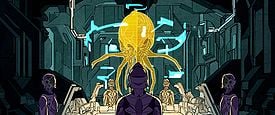

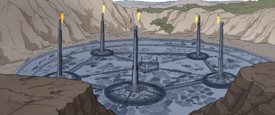


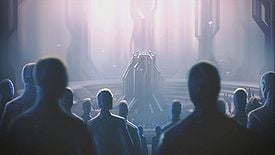
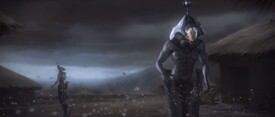

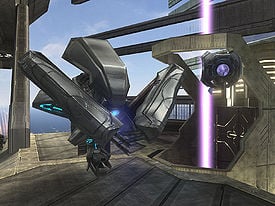


![A Forerunner activating a console, showing a remarkable similarity to a human hand. Note that this depiction may not be accurate.[123]](https://halo.wiki.gallery/images/thumb/f/f5/Forerunner_Apex.jpg/200px-Forerunner_Apex.jpg)

